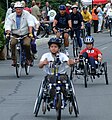Wikijunior:Transport/Vehicles

Unmechanised
[edit | edit source]Although walking and horse riding has survived as a means of transport, the term vehicle is generally taken to exclude walking and horse riding. However the term vehicle can include unmechanised vehicles without wheel and axles. In particular this can be seen in aviation and watercraft. For example, hot air balloons and hang gliders in aviation. In watercraft, unmechanised vehicles can include yachts, canoes, kayaks and rowing boats.
Collective
[edit | edit source]In land transport there also exists interesting phenomenon as walking buses and bike buses/ bike trains, convoys and wagon trains. These are collective forms of transport (that could loosely be termed vehicles) but not mechanised in the whole (the linking together is unmechanised unlike locomotives or road trains) only in their individual unit parts except the walking bus.
Mechanised
[edit | edit source]Mechanised vehicles on land transport involve wheels and axles. Mechanised vehicles can be animal, human, or wind powered, but were greatly transformed by the internal combustion engine and the motorisation process since the Industrial revolution in the 19th century.
Aviation
[edit | edit source]Aviation vehicles include hot-air balloons, airships, airplanes, fixed-wing, helicopters, hang gliders. The fastest vehicles of any mode of transport are rockets travelling by air.
Animal
[edit | edit source]
Animal-powered vehicles include ox-carts (carts drawn by oxen), horse carts, dog sleds, horse-drawn carriages, horse-drawn trams, horse-drawn omnibuses. These enjoyed centuries of use, only walking has been used by humans as transport for longer.
Cable
[edit | edit source]Cable vehicles include funiculars and cable cars. One interesting water transport is cable ferries. Also zip lines.
Human-powered
[edit | edit source]Human-powered vehicles include Bicycles, scooters, tandems, unicycles, quadracycles, rollerskates. The Bike boom took place in the 1880s.
Military
[edit | edit source]Military vehicles include tanks, ships, aircraft carriers (which are ships) and fighter planes.
Road
[edit | edit source]
Road – motorisation – motorised vehicles include cars, electric bicycles, motorcycles (motorbikes), buses and coaches. Also escooters and segways.
Off-road
[edit | edit source]
Off-road motorised vehicles include quadbikes (ATV), snowmobiles and dirt bikes. Off-road rockets are the fastest land vehicles setting land speed records.
Rail
[edit | edit source]Rail vehicles include both light rail such as trams, interurbans, and heavy rail trains. Railwaymania took place in the 19th century.
Ships
[edit | edit source]
Ships include canoes, outriggers, catamarans, cruise ships and ocean liners, the latter two largely driven by combustion engines as opposed to human, animal or wind power. Canalmania took place in the 17th century. Yachts use sails driving by wind power for motive force. Canal barges have been horse-drawn. Steamships (SS) powered by steam engines revolutionised reliable ocean liner travel across oceans previously undertaken by sailing ships.
Space
[edit | edit source]Space vehicles include space shuttles, rovers and satellites. The space race took place in the 1960s.
Gallery of vehicles used or operated by children
[edit | edit source]-
Roller skates
-
Toy wagon
-
Trikke
-
Sled
-
Bicycle
-
Recumbent tricycle/trike
-
Trike
-
Baby trike
-
Kickbike
-
Kick scooter
-
Walking bus
-
Gokart
-
Pram
-
Dog mushing
-
Bicycle with sidecar
-
Horse riding
-
Children's railway operated by children
-
Go-cart
-
Cargo bike
-
Rowing boat


















